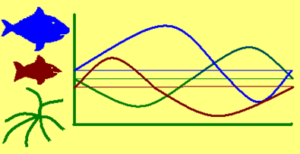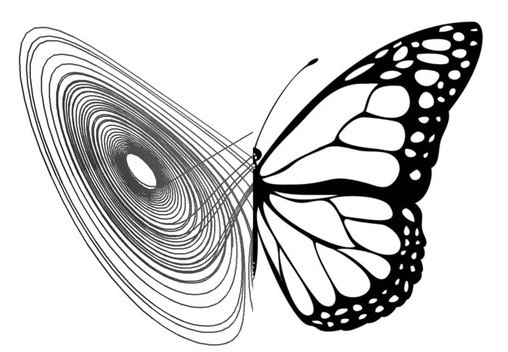Chaos theory, contrary to its title, which insinuates chaos and anarchy, attempts to create the understanding that there are always underlying (seemingly hidden) interconnections between seemingly random/irregular events. Finding these interconnections or hidden patterns in every field of existence and life is the main mission of chaos and complexity scientists. In the view of chaos, all activities in society and nature are collective activities and each individual is an indivisible part of the whole (society). One of the seemingly hidden patterns are attractors. Even in nonlinear systems that seem to always have unpredictable consequences, there are deep structures known as attractors. An attractor is actually an organized principle and is an inherent form of things that the phenomenon in question always tends to in its evolutionary stages. Let’s start with a simple example, when you take a pendulum out of a vertical and stationary position and release it at an angle theta, the pendulum will eventually return to its vertical and stationary position after swinging several times. The vertical position for the pendulum plays the role of an attractor.

Or in a similar example, if you drop a marble in a bowl on the table, the marble will end up in the center of the bowl after going up and down several times. The center point of the bowl and the vertical point of the pendulum are actually the attractors of the marble and the pendulum. These types of attractors are point attractors.

Other types of attractor patterns can be easily obtained by traditional analysis. For example, in a sine graph that is drawn with its wave order in a graph, the periodic repetition of the graph can be made into a pattern that predicts the next changes of variables towards the pattern of the graph. This range of changes is called static attractors or periodic attractors.

When you go to your workplace on a daily basis, your workplace is considered an attractor for you. If you periodically go to a park, coffee shop or any other place with your friends after work, those places are considered attractors for you. And if we consider your route to work and to the park/coffee shop together, you are in a limited cycle attractor. This means that your work is repeated periodically and in specific periods.

limit Cycle Attractor
Attractors are not only found in the physical world, but also in the world of the mind. People’s world views, viewpoints, opinions, beliefs and mental models play the role of attractors in the world of the mind. Because as soon as a person is in an unknown situation and faces information with uncertainty (chaos), he refers to his mental model, beliefs and opinions and analyzes the existing situation with them and reacts. Each person’s personality also has a similar attractor mechanism. Because a person acts in different situations and during the time when he physically undergoes extensive biological changes (gets old) based on his personality and identity and follows his own behavior pattern.
Although people’s personality changes with the occurrence of different events, but these changing behaviors also follow specific patterns or in other words, specific attractors. Even human long-term memory works based on the process of attractors in chaos theory. That is, a specific question or concept causes certain neural networks in the brain to be activated non-linearly. This particular neural network, in fact, plays the role of attractor for that question or concept.
That is, whenever that question or concept is repeated again, the same neural networks are activated and the answer comes to the person’s mind. These types of attractors, which exist in the mind and brain and other complex systems, are known as strange attractors. That is, they do not have a point or periodic state, but although they have a specific shape and form, they are never exactly repeated in different situations. Edward Lorenz’s strange attractor is one of these types of attractors. The story of Edward Lorenz is very famous.
He had built a mathematical model to predict weather conditions for long term. One day he realized that by making very small changes (a few hundredths) to the variables of his model, he got very different answers. That is, his model was very sensitive to very small changes in the initial conditions and obtained very different answers, but the remarkable thing was that all his answers were obtained in the same range and followed similar diagram, whose diagram was very similar to a butterfly.
This butterfly diagram was actually the attractor of his intended system. But because the shape and changes in these attractors were very unusual and non-repetitive, they gave it the title of strange attractors. The phrase “butterfly effect” was proposed in chaos theory from this experiment, which is a very basic concept in chaos theory.

Diagram of Edward Lorenz’s Experiment
In fact, strange attractors are characteristics of chaotic systems, where the changes of the chaotic system occur unpredictably in a limited range. In other words, the strange attractor is the pattern of the trajectory of the chaotic system, which expresses the general behavior of the system through various diagrams and shapes. Despite the fact that the behavior of the chaotic system is unpredictable and irregular in the range of the strange attractor, but the same strange attractors create the basic order and structure in the chaotic system. Strange attractors have a fractal structure. That is, a specific pattern is repeated in different scales.

Charismatic leadership, training, and structural principles governing a system also play an attractor role. Even an organization itself or its brand name (specific brand) and the strategic logic governing a system (which mostly comes from the collective mental model and its identity) also play the role of a strange attractor. The interesting point here is that the strategic logic governing a system is more of a story and myth. That is, stories and myths can also play the role of strange attractors. The important strategic issue for a system or organization is that the strength of that system/organization against changes is determined by the strength of the attractors of that system/organization.
If the strategic logic governing the organization, its leadership, the trainings given to the employees, its executive and structural principles cannot maintain its strength and stability against changes for any reason and other attractors in the environment of that organization can maintain their stability, in that case all the values in the environment will go to new attractors and that organization will decline. So, the attractors determine the real and possible change from among a range of possible ones. The forces that determine an actual change from within the range of possibilities are called attractors.
In other words, the attractors are also the determining forces of the future. It can even be claimed that futures are always built on the strange attractors. When you build several scenarios for the future of a system and finally develop robust strategies for the system, you have actually prepared strange attractors to that system. These strange attractors change the strategic logic (individual and group mental model) of that system and you will lead them to new attractor/s in the environment.
Now, how correct have you been in determining the strange attractors, or have you identified the real attractors in the operating environment of that system? It is a separate issue.
If we refer to the first statements of this discussion, it was found that a series of hidden patterns have connected all the systems in existence. That is, there are no random and irregular events, not knowing and not understanding the mutual connections between the events in existence is because those are currently hidden from human sight and mind. Chaos theory tells us that the universe and nature are full of “Co-evolutions” and “cooperation”.
In Chaos’ view, competition is a reductionist concept. Competition and cooperation are not either/or ideas, but are intricately intertwined. Chaos theory negates the “dualistic” view.
The conclusion: whether it is a black hole in the universe, whether it is a galaxy with billions of planets and stars, whether it is a specific organization and business brand, whether it is a mental model and belief, whether it is a story and myth, or whether it is a specific and repetitive pattern of behavior, the Existence is full of attractors. The evolution of existence and human life also includes moving from attractors to other attractors in a chaotic path.

 فارسی
فارسی
